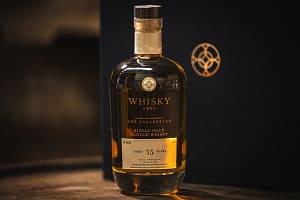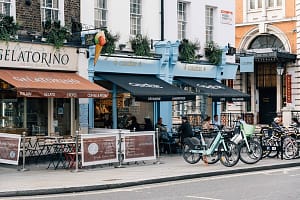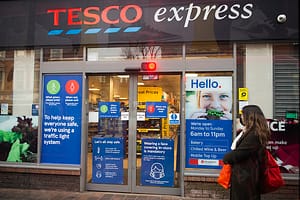Is our male-about-ale Pete Brown right? Tweet us @Londonlovesbiz
If I asked you what you wanted to drink with a really great meal, unless you’re teetotal I’m guessing your decision-making process would largely centre around the question, ‘red or white’?
It’s OK, I’m not judging: we’ve all been conditioned by the fact that most of our ideas about high culinary standards come from France, and the French make better wine than they do anything else.
Of course, you’d expect me to point out now that beer is just as good a match with food – if not better. A lot of beer writers have written a lot of words about this over the last decade or so. Garrett Oliver, brewmaster at the Brooklyn Brewery in New York, wrote the seminal work on beer and food matching – The Brewmaster’s Table – in 2003, and it was all the more convincing because Garrett makes no secret of his love of fine wines. He simply believes beer is a better match with food.
But beer still struggles to claim its place at the dining table. Of course, you’re likely enjoy a good pint rather than a glass of vino with a steak and ale pie or fish and chips (unless you find yourself on the BBC’s pathologically beer-phobic Saturday Kitchen) but beer only ever seems to wash down plain, honest, stodge. Even the new wave of craft beer bars focus on pairing beer with dirty burgers, sliders and wings.
Beer and burgers are both more accessible and straightforward than haute cuisine and fine wines. It’s right that they go together. But is that all that beer is capable of, gastronomically?
Michel Roux Jnr doesn’t think so. He already has interesting beer lists in all his restaurants, and earlier this year he ran a competition among London’s craft breweries to find a special ‘house’ beer that would work particularly well with Roux-style food. The winner was a beer by Four Pure, a brewery founded in October 2013 by brothers Dan and Tom Lowe, who poached American brewer John Driebergen from Meantime Brewing to be their brewmaster. Driebergen created a Belgian style witbier brewed with grapefruit and orange zest and coriander seeds. Roux felt it ‘has a sing about it’, and that it would be perfect with his summer menu.
This theme of American and French collaboration on English soil was expanded in dramatic fashion a couple of weeks ago. A delegation from the American Brewers Association was in town for various beery events, one of which was an epic lunch at Smithfield’s Michelin-starred Club Gascon.
This is a restaurant that specialises in the cuisine of southwest France, home of cassoulet, foie gras, duck, and chef Pascal Aussignac. Accompanying the food, the wine selection at Club Gascon is usually focussed around the Languedoc Roussillon and Bordeaux areas. ‘There is no wine from Burgundy or the new world’, intones the restaurant blurb solemnly.
So it’s a bit of a stretch, to out it mildly, for Chef Pascal to create a menu themed exclusively around pairings with American craft beers, and this was the first time he had ever done so.
He didn’t do badly for a novice.
As you’d expect from a restaurant of this standard, the dishes sound mindboggling and sometimes almost ludicrous on paper, but look like miniature works of art and taste divine when they arrive. (The difficulty in describing such dishes in mere words is the only acceptable justification for taking photos of your food.)
Truly great cuisine is all about the flavour trails – the understanding of how different, often unlikely ingredients can be so much more than the sum of their parts when combined. The very best dining experiences make the drink an additional, optional coda to the flavours on the plate, sometimes subtly enhancing, other times transforming something that should also work perfectly well on its own.
We started with Gillardeau oysters, apple crush, seaweed tartare and black tea tuile, a delicate and polite arrangement of subtle flavours, an edible minuet, accompanied by Oarsman, a take on the once dead, now re-emerging Berlinerweisse-style beer from Bell’s Brewery in Kalamazoo, Michigan. There couldn’t be a better example of an unlikely-sounding pairing working so wonderfully. The beer’s crisp, delicate tartness and the saltiness in the dish was like taking your palate for a perfect spring day out at the coast.
Silky duck flan with ginger and hay jus was paired with two different pale ales – Deschute’s Mirror Pond Pale Ale and Boulder Beer’s Hazed and Infused. The beers worked fine with the food, but as is sometimes the case, here it was the food that brought out the best in the beers, making the hops sing with freshness.
Cappuccino of black pudding, lobster and asparagus benefited from stronger, heavier IPAs from Founders and Lagunitas – two brewers currently benefiting greatly from the 45% increase in exports to Europe from the American craft beer scene over the last twelve months. An amber lager from Wisconsin’s Stevens Point (now available in some British supermarkets) and Brown Dog Brown Ale from Smuttynose (New Hampshire’s leading craft brewery, but not yet widespread in the UK) dialled up the sweet, nutty, biscuity side of the beer equation to go well with wood pigeon, orange, barigoule and glazed kumquat.
Even when people tentatively accept the possibility of pairing beer with fine food, many draw the line at dessert. Even wine has to offer up a specialised, niche version of itself here, to do something mere red and white cannot. But the pairing of a Millionaire shortbread with coffee, pink praline and Worcesterhsire Sauce ice cream (yes, really) with both Old Rasputin Imperial Stout and a Chocolate Hazelnut Porter from the appropriately named Heretic Brewery show just how easy beer can go where wine cannot. In fact it was almost too easy. Pairing chocolate and coffee flavours in the food with chocolate and coffee notes in the accompanying drinks is so simplistic it’s almost cheating. But it’s so perfect you’d be a fool not to indulge.
This is what beer does that wine often struggles to do: pairing like flavours in food and drink is beer’s first secret weapon as a food match. Wine usually offers a pleasing contrast, a counterpoint to the dish. Beer can do that too. But it can also pick up and run with the flavours in the food much better than wine can.
Beers other secret weapon is only revealed in setting such as this – which is why, on the rare occasions it gets the chance, it often blows the minds of even the most sceptical diner.
The truth is most of us think very little about how flavour pairings work together. We choose a dish we like and a wine we like. These days, many of us like bigger, bolder, fruity New World wines which are wonderful on their own – I drink them heartily – but can stomp all over the flavours in food.
Beer is often subtler and more delicate. Taste beer and wine side by side, and the relative intensity of character usually works better with beer than wine even before you get onto matching specific flavour components.
Michelin-starred chefs – the honest ones at least – understand this perfectly. If Bordeaux brewed decent beer instead of making wine, this wouldn’t even be a contentious thing to write. If you don’t believe me, ask Pascal Aussignac or Michel Roux Jnr.
NOW READ
Hula hooping, Ken Livingstone and sewers – these lovely videos tell Londoners’ stories
The first in our series from the 1000 Londoners project

10 highest paid DJs in the world
I think it’s fair to say they are minted









Leave a Comment